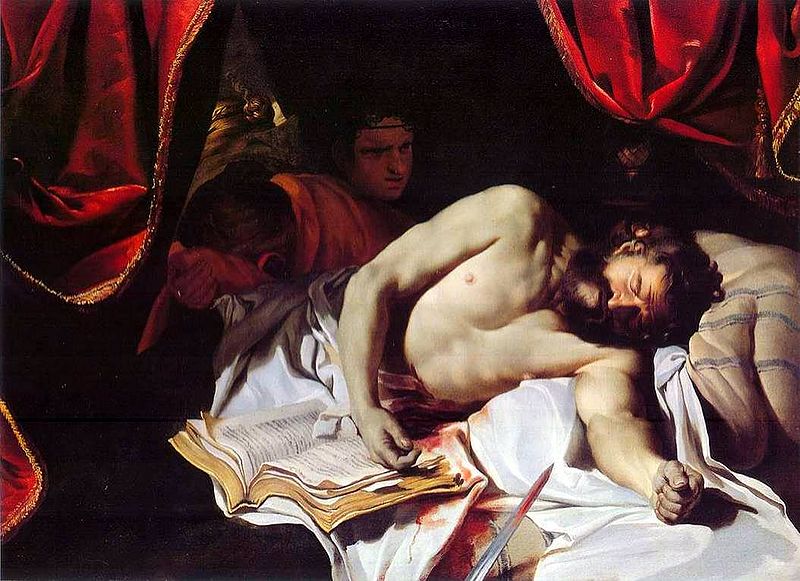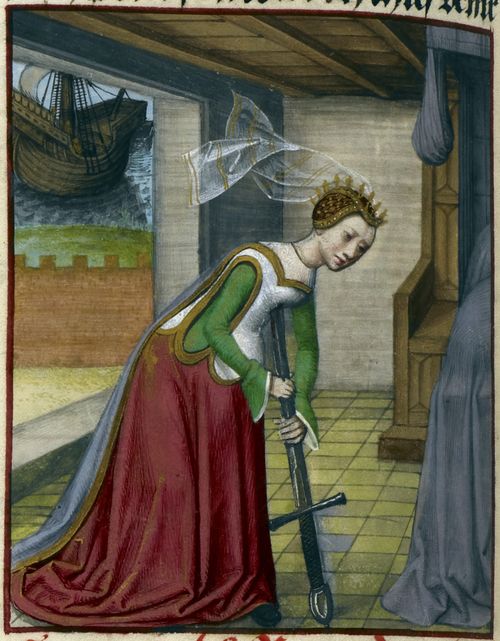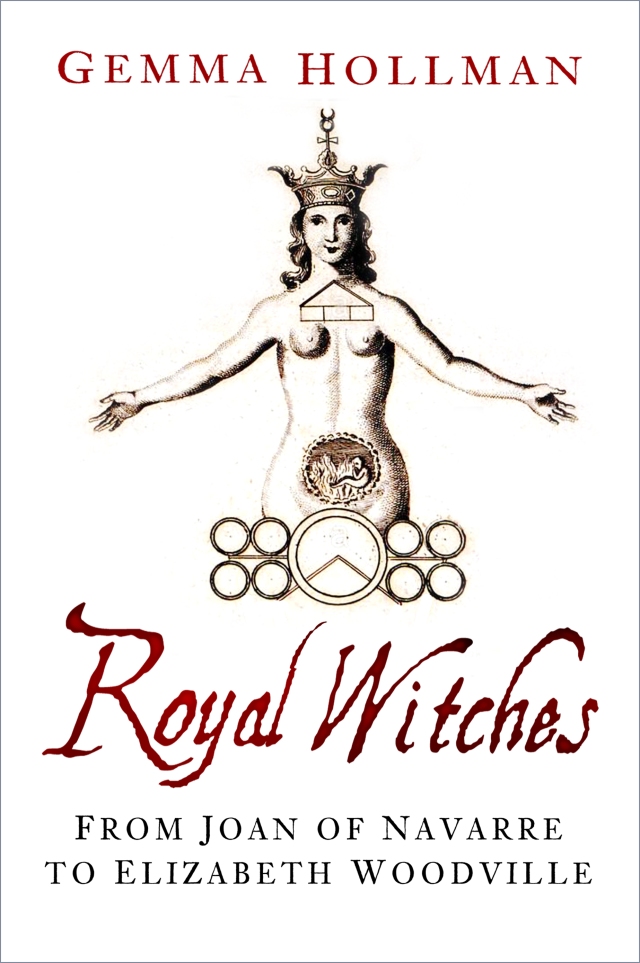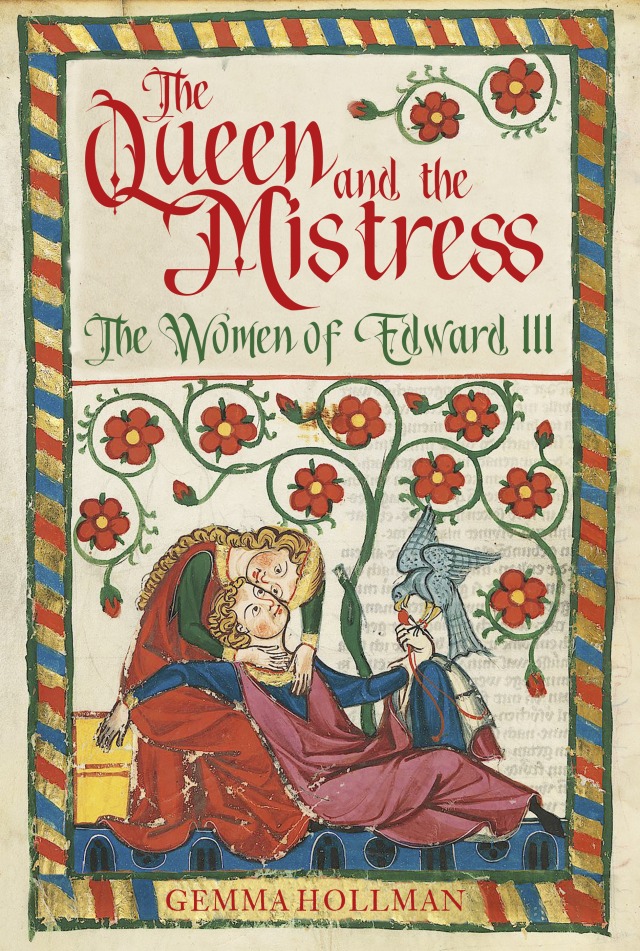People who lived in medieval Europe were, by and large, part of a Christian population. Whilst the strength of religious beliefs, and the Church’s control over individuals’ lives, did vary from person to person and region to region, generally people were aware of and wary of Church laws. As the medieval period progressed, the Church was also able to exert more influence over the law, meaning that if you contravened Church teaching you could find yourself punished secularly.
Attitudes to suicide changed in Europe as the Roman Empire fell, and Christianity took a greater hold in the new states. Under Roman beliefs, suicide wasn’t always frowned upon, and in some cases it was even exalted. In the colony of Massalia (present day Marseilles), if someone wanted to kill themselves then they could petition the Senate, and if their reasons were judged to be legitimate, then they were allowed to do so without consequence. ‘Patriotic’ suicide existed, to avoid dishonour, and this was often performed by leaders – for example, Cato the Younger killed himself after his side’s defeat at the Battle of Thapsus. It was considered more honourable for him to kill himself here. However, the lines for patriotic suicide were strict, and the suicide had to be done for virtuous reasons rather than personal. For this reason, Mark Antony’s suicide was frowned upon because he killed himself for love.
 Cato the Younger’s suicide,“Suicídio de Catão de Útica,” Charles Le Brun, c. 1646.
Cato the Younger’s suicide,“Suicídio de Catão de Útica,” Charles Le Brun, c. 1646.
There were some arguments against suicide, but this was usually based on the harm to society of a particular person’s death. For this reason, suicide was not allowed for slaves, soldiers, or those accused of capital crimes. If they committed suicide, slaves would deprive their owners of labour, criminals would deprive the state of conviction and thus the ability to seize their property, and soldiers obviously harmed the protection of the empire. As Christianity spread, and the authority of the church grew, suicide became more and more taboo, with spiritual connotations.
The Church was not so concerned with the idea of suicide depriving a community, so much as the mortal sin against God that committing suicide would be. The Church’s abhorrence of suicide is summarised by Thomas Aquinas (living in the thirteenth century). Aquinas gave several reasons why suicide could not be committed by a Christian. Firstly, he quoted Saint Augustine (who wrote back in the fifth century), who said, “Hence it follows that the words ‘Thou shalt not kill’ refer to the killing of a man—not another man; therefore, not even thyself. For he who kills himself, kills nothing else than a man.” Aquinas goes on to argue that suicide contravenes the natural order of things, as it is the nature of all things to strive to survive, and anything that contravenes nature is inherently a mortal sin. Moreover, suicide is automatically a sin against God, because only God has the right to bring life and decide death, and so to kill yourself you are going against God’s authority. Finally, Aquinas revived the old argument of Greek philosophers, saying that to kill yourself meant that you were causing injury to the community, seeing as every person is part of the community, and so belongs to it.

Saint Thomas Aquinas, from a 15th century altarpiece in Ascoli Piceno, Italy, by Carlo Crivelli.
As such, even in the earlier medieval period, efforts were made to deter would-be committers of suicide by creating punishments after death. In England, the first such legislation was drawn up by the Archbishop of York in 740, which ordered priests not to give Christian burials to anyone who had committed suicide (as long as it was proven that they were sane at the time of their death). This idea of punishment through burial consolidated and expanded throughout the medieval period. Masses were not allowed to be sung for anyone who had committed suicide, and they were not allowed to be buried in holy ground. In England, the practice emerged of burying those who had committed suicide at a crossroads, with a stake through the heart. Sometimes the body was dragged through the streets prior to burial.
This practice probably emerged from old Anglo-Saxon superstition that continued through to later medieval times. Anglo-Saxons had buried those who had been executed (and presumably then viewed as criminals) at crossroads, and as those who had committed suicides were criminals for sinning against God, they too must be buried as criminals. The superstitious aspect is evident also; it was believed that burial at a crossroads would confuse the ghost of the deceased (which was also why it was a punishment for criminals), as the ghost would not know which direction to travel. The ghost would thus be stuck waiting at the crossroads forever. The dagger through the heart was also an attempt to pin the spirit to the body, possibly denying the deceased the ability to rise on judgement day. The deceased would also often be excommunicated for their crimes against God, again signifying that their souls were in danger of being trapped forever in purgatory – or even being sent to hell.

Those who committed suicide were increasingly denied a Christian burial in a Churchyard, done by a priest, as in the above image from a French Book of Hours, c. 1490. From The Hague, MMW, 10 F 17, 73r.
More pressing for the relatives of those who committed suicide, suicide also had implications in the secular world. As Aquinas argued that to commit suicide took away God’s control, just as to kill a slave deprived the slave’s master, this translated into the medieval world. Peasants belonged to their lord, lords to their kings – if you killed yourself, you deprived your lord and thus your king of your labour. This was therefore essentially theft and meant that the Crown should have rights to seek compensation for your theft. This meant that those who committed suicide would have their goods and property confiscated by the crown. In a society where men generally were considered the owners of most property, if a man committed suicide then his goods reverting to the Crown meant that his widow and children could be left without a penny.
As such, clearly the surviving family had a vested interest in stopping the ruling of suicide by the coronor in such a case. Sometimes family members would take this into their own hands by trying to bury the body themselves, or to hide some of the deceased’s possessions to stop them being assessed for confiscation. For example, in the Eyre of Somerset, 1280, it is recorded that:
“William de Wedmore, vicar of Chryriton hanged himself in his own home in the same village. The verdict was suicide. And Walter de Wedmore and John his brother(s) buried the said William without view of the coroner and took his chattels, value 34s so they are to be arrested. Afterwards they came to court and the sheriff let them go.”
In smaller communities, where there was a strong sense of community spirit and everybody knew each other, acts of suicides were often covered up to spare the family the shame of being associated with suicide, and to protect their property and goods. As such, suicides by drowning were ruled as accidental drowning, and men who stabbed themselves were recorded as having “fell on his sword”.

A woman “falling on her sword”. Detail of a miniature of Dido committing suicide as Aeneas sails away, c 1490 – 1500, Harley MS 4425, f. 117v.
Whilst medieval Europeans were harsh on those who committed suicide, they were not completely blinded by a wish to punish, and they did recognise that there may be circumstances where the person was not in their right mind and so did not commit suicide knowingly. Those who were clearly suffering from mental illnesses may have been described as being in a frenzied state, or possessed by demons (because demonic possession was the only logical explanation for a Christian sinning by committing suicide), and so they could not have known what they were doing. There are several examples of this in the English Eyre rolls from the late thirteenth century:
“William la Emeyse of this vill, suffering from an acute fever which took away his senses, got up at night, entered the water of Kentford and drowned himself. The jury was asked if he did this feloniously and said no, he did it through his illness. The verdict was an accident.” (Eyre of Hereford 1292)
“Thomas, son of Henry Robekyn of Brandon, in a frenzy (habens frenesium) cut off his left foot with an axe and then his left hand, in the house of the said Henry, his father, in Brandon, and the following night he died from this. The first finder and four neighbours came and are not suspected. The jury, asked if they suspect anyone else of this death say no and say that the said Thomas straight after the deed came to his senses (reddit’ ad sensum proprium) and had the last rites of the church before he died. So the deed was done through loss of sense and not feloniously. So the judgment is accident.” (Eyre of Norfolk 1286)
These examples, especially the second, demonstrate that there was this idea that someone could have leave of their senses through illness or demonic possession, and thus was led to carry out an act they would never do in their sane mind. Thomas’ repenting before his death showed that when at his senses he would never have committed such an act, and thus officials were happy to rule it not as intentional suicide, but an accident.

A woman who committed suicide by hanging, shown here as being influenced by demons. From Rappresentatione della passione. Florence, 1520.
The judgement of accident instead of suicide was more readily handed out when the acts could easily be viewed as spontaneous, such as through drowning or injuring oneself with a sharp weapon (sword, knife etc) as this could be seen to be done on the spur of the moment, a temporary fit of insanity. However, the most common method of committing suicide was through hanging, which significantly reduced the rulings of accidental death. Hanging oneself was seen as a more calculated act that required more planning, and so it was harder to argue that it was done under spontaneous insanity.

Enjoying this blog post? Buy me a hot chocolate!
Consider donating the cost of a hot chocolate to me, so I can continue to write and run Just History Posts.
£3.50
Whilst medieval Europeans were aware to some extent of depression, depression was not seen as a valid excuse to commit suicide, and did not come under the excuse of not being in one’s right mind to receive a ruling of accidental death. Members of the church who lived in monasteries became particularly aware of the state of ‘melancholy’, a deep depression. St John Cassian (d. 435) spoke of a depression he called acedia which he thought endangered his monks. In legal records judging suicides, it is often mentioned if the person had recently been bereft – although again, whilst recognising that the suicide may have been because of the bereavement, it is not justified as a legitimate reason to commit suicide. To commit suicide because of a ‘melancholy’ mood was not seen as a reason to commit suicide, because it was a Christian’s duty to endure hardship. To kill yourself for a worldly reason – debt, having committed a crime, bereavement, etc – was to have turned your back on God and to have given in to doubts of his omnipotence and mercy. Christians were supposed to endure whatever hardships God had given them, in order to be rewarded in the next life.

Lucretia commits suicide after her rape; detail from “Memorable Deeds and Sayings of the Romans”, Koninklijke Bibliotheek, c. 1470, The Hague, MS 66 B 13.
For this reason, a person’s religious reputation was also integral to whether a suicide would be ruled as an accident or not. If to commit suicide was to turn your back on God, to embrace the devil and his demons, and doubt God’s power and laws, then someone who prior to death had been seen as un-Godly, had committed crimes, not attended church, or had spoken in a way to suggest their faith was being lost was clearly more likely to have been aware of their actions. It was incredibly difficult for medieval people to rectify the idea that a committed Christian could ever commit suicide, knowing the implications and consequences. Therefore it would be easier to declare a fit of temporary insanity, of not being of sane mind, on someone who was viewed to be a good Christian – as clearly they would never commit suicide in their right mind.
Medieval people struggled with suicide for centuries. The inability to align Christian beliefs and teachings with the implications of committing suicide made it difficult to understand why someone could commit suicide, and led to extremely harsh punishments after death. People would try to avoid the pronouncement of suicide, both to protect the surviving family’s property and reputation, as well as the reputation of the deceased. Many suicides were ruled as accidents, or as having being carried out in a state of insanity, either due to an inability to prove intent, or as an act of mercy for all involved. Mental illnesses were recognised as a reason someone may commit suicide, but unless the mental illness led to erratic behaviour recognised as abnormal by many prior to death, it was often not enough to excuse the deceased from their crime.
If you’re going through a difficult time, a list of international suicide hotlines can be found here: https://www.suicidestop.com/call_a_hotline.html
Previous Blog Post: Royal People: Joanna of Castile, Mad or Maligned?
Previous in Miscellaneous: The Book of Kells, a Medieval Masterpiece
List of Blog Posts: here Blog Homepage: here
Buy my books via the pictures below! Or why not check out our shop?

Follow us:
You can read more about this topic via the following:
Gender in Late Medieval and Early Modern Europe, Marianna Muravyeva, Raisa Maria Toivo (Routledge, 2013).
http://www.historyextra.com/qa/why-suicides-buried-crossroads
http://www.oddlyhistorical.com/2015/09/27/crossroads-suicide-burials/
https://stpeterslist.com/aquinas-on-suicide-3-reasons-it-is-unlawful-to-kill-oneself
Suicide or accident – self-killing in medieval England, Series of 198 cases from the Eyre records, Alice Seabourne, Gwen Seabourne, The British Journal of Psychiatry, Jan 2001, 178 (1) 42-47.






Great article!
It’s really interesting to see suicide through the lenses of history.
LikeLike
Thank you very much! Yes I think it’s something people don’t really think about but obviously has had changing attitudes over time
LikeLike
Reblogged this on Lenora's Culture Center and Foray into History.
LikeLike
A really interesting entry . I had not really given much thought to the cencept of people (or rather their estates ) bein g punished for committing suicide.
LikeLiked by 1 person
Thank you! Yes you wouldn’t think there would be extraneous punishments like that
LikeLiked by 1 person
Please add information about help lines for those with suicidal thoughts as is common journalistic practice today.
LikeLike
I have updated accordingly, thank you
LikeLike
Thanks a lot for adding information about suicide helplines!!!
LikeLiked by 1 person